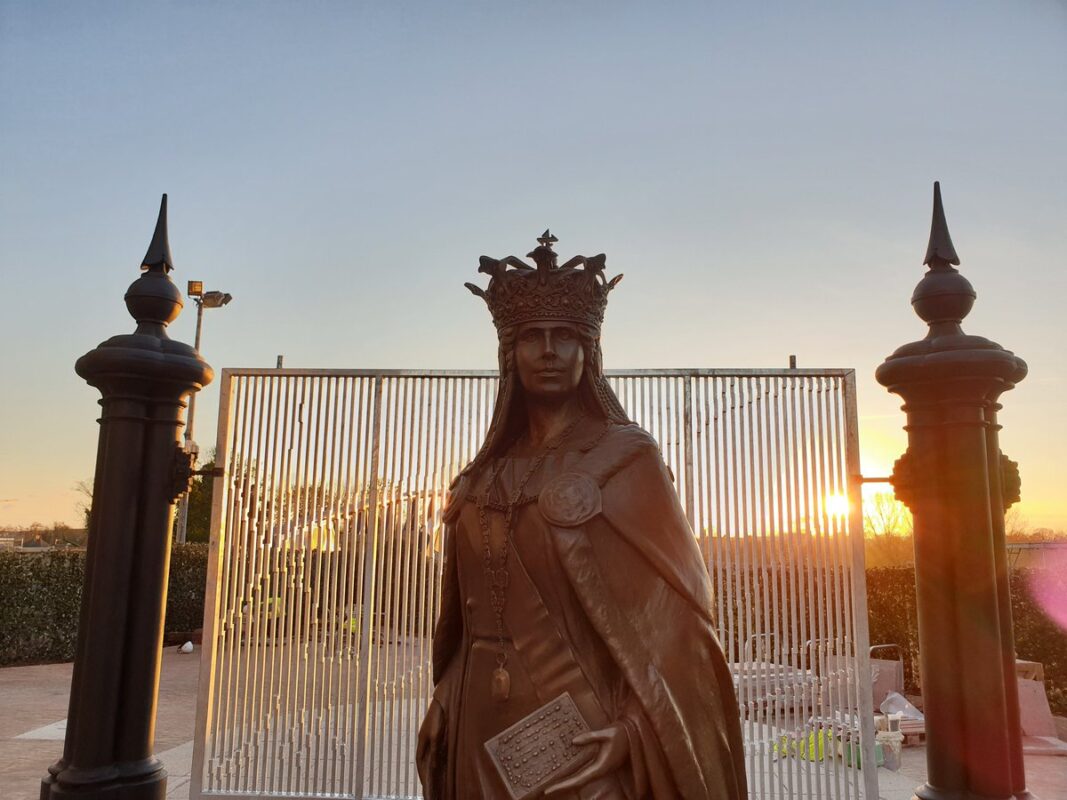Princess Marie of Edinburgh (1875 – 1938) was born and spent her childhood at Eastwell Manor Park in Ashford, later becoming Queen of Romania in 1914 and reigning until 1927.
Situated at the end of The Piazza, next to the original, restored Cattle Market gates and to the backdrop of Victoria Park, named after her paternal grandmother, you’ll see the magnificent bronze Queen Marie of Romania statue.
Commissioned in 2018, the 2.2m high statue is the work of sculptor Valentin Duicu, a graduate of the National University of Arts in Bucharest who won the contest organised by the Romanian Cultural Institute (ICR) for the monument. It was unveiled to honour the revered British princess and Romanian queen, one of the most important bridge-personalities between the two countries, and to mark 100 years since the unification of Romania in 1918. It is the first such monument to Queen Marie outside of Romania.
Queen Marie of Romania
The future Queen was born on 19 October 1875 at Eastwell Park, her family estate in Kent, as the daughter of Alfred Ernest Albert de Saxe-Coburg and Gotha, the Duke of Edinburgh and Queen Victoria’s second son, and Maria Alexandrovna Romanova, Grand Duchess of Russia. On 15 December 1875, in the presence of her royal grandmother, Marie was baptised in the Anglican Church at Windsor Castle.
A projected marriage between Marie and her cousin, George of York, the future George V, encouraged by Queen Victoria and supported by their fathers, the Duke of Edinburgh and the Prince of Wales, failed because of the opposition of the young heirs’ mothers, the Duchess of Edinburgh and the Duchess of Wales. Instead, on 10 January 1893 at Sigmaringen Castle, after a brief engagement, Marie married Ferdinand of Hohenzollern-Sigmaringen, the heir to the Romanian throne. In 1914, after the death of King Carol I, Ferdinand and Marie became Romania’s monarchs. In the summer of 1916, Romania entered the First World War as part of the Allied Powers.
From the first day of the war, Queen Marie undertook an active role that would soon transform her into a role model. Beautiful, full of wit and intelligent, cultivated and possessing a strong personality, the queen caught the imagination of her contemporaries, Romanian and foreign alike. The Queen devoted all her energy to the war effort. She tirelessly visited the camp hospitals, set up relief schemes, managed the medical support, attended military and civilian ceremonies, raised money for the wounded, the war prisoners and the widows, and kept the British and French allies closer. She later became a pivotal figure at the Paris Peace Conference, which recognised the unification of all Romanian provinces in one, democratic state, where the Queen used her brilliant diplomatic skills and her vast array of connections to secure a favourable outcome. “From My Heart to Theirs”, an article published during the war, summoned an entire way of life, dominated by the unconditional love for her adoptive country. And her Romanian subjects reciprocated with an equal passion.
Endowed with a great artistic flair, she also devoted her time to writing, architecture, and design, as well as to various social and cultural causes, which made her one of the most admired royals of her time. On 18 July 1938, she died at Pelișor Castle in Sinaia, Central Romania, her beloved mountain retreat built under her guidance.
“We are going to war! There is war on the side of The Allies! There is war against Austria. There is war against Germany. Our dear little country has become the ally of my beloved England, of France, of Russia, of Italy, Serbia, Japan, of little heroic Belgium. In the North, we are fighting against the Austrians and the Germans. In the South, we are facing the Bulgarians and the Turks, although I have always been told we are not strong enough to fight on two fronts at the same time. Well, we will see. […] In the hospitals, the wounded – they all greet me with heart-warming joy and that is why I feel my visits are meaningful. I bring them flowers, sweets and cigarettes. I spend the most time with the seriously injured. They don’t complain at all. And there is one thing that makes me shiver and brings tears to my eyes…When I ask them if it hurts they say to me ‘it hurts, but it doesn’t matter – may your majesty become the Empress of all Romanians’ …an eternal chorus…Every humble life…ready to give its last drop of blood so I can, one day, become the ‘Empress of all Romanians’. A day all these brave soldiers might not survive to witness.”
Queen Marie of Romania, Wartime Diaries

